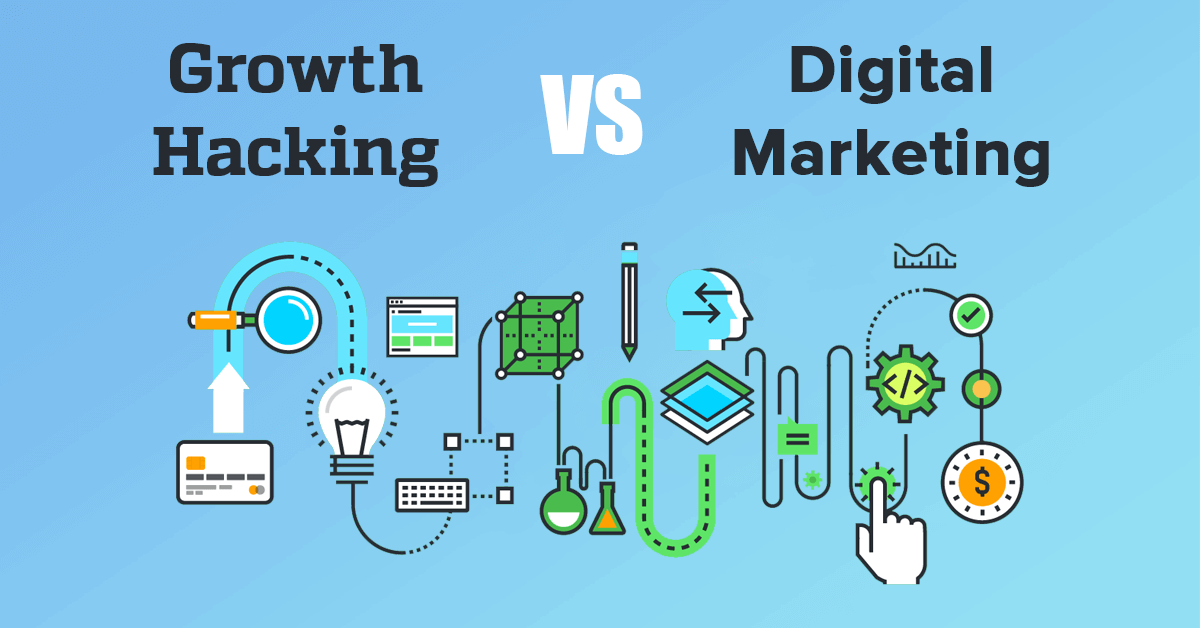Growth hacking and digital marketing both aim to boost a company’s customer base and revenue. But they are not the same. And understanding the differences is key to implementing these strategies correctly.
Growth hacking is essentially a subset of digital marketing focused primarily on rapid growth through any means possible. Growth hacking is a short term strategy and is driven by experimentation and creative tactics. Digital marketing, on the other hand, encompasses a broader, more systematic approach to building a lasting online presence.
Let us take a look at the differences between the two from various angles.
1. Objective
Growth Hacking: The primary focus is on rapid growth in a short period, often with an emphasis on scaling with low cost and innovative strategies. Startups and smaller companies typically use growth hacking to see immediate gains.
Digital Marketing: Focuses on increasing and maintaining a long-term online presence and building brand reputation across various digital channels. This can include a comprehensive approach using SEO, content marketing, social media, and more.
2. Strategies
Growth Hacking: Utilises creative, experimental, and low-cost strategies to quickly increase the number of users, revenue, or impacts. This could include viral marketing, product hacks, unique partnerships, or leveraging data analytics to identify and optimise rapid-growth strategies.
Digital Marketing: Uses established techniques to gradually improve engagement and conversions over time. Strategies often include email marketing, Pay-per-click (PPC) advertising, social media management, and content creation.
3. Time Frame
Growth Hacking: Targets immediate results, focusing on agility and quick adaptation to capitalise on short-term gains.
Digital Marketing: Plans for mid to long-term results, focusing on sustained, incremental success.
4. Tools and Techniques Used
Growth Hacking: Often involves A/B testing, landing page optimization, viral factor analysis, social media metrics, and anything that can be leveraged for quick scale.
Digital Marketing: Relies on SEO tools, content management systems, social media platforms, customer relationship management (CRM) tools, and more comprehensive analytics tools.
5. Focus on Metrics
Growth Hacking: Closely focused on metrics that directly relate to growth such as customer acquisition costs, lifetime value, funnel conversions, etc.
Digital Marketing: Monitors a broader array of metrics like engagement rates, click-through rates, return on investment, and organic traffic, among others.
6. Target Audience
Growth Hacking: The target is often very fluid; grows hackers might redefine target demographics quickly as they discover new growth opportunities through experimentation.
Digital Marketing: Works with a well-defined target audience and persona, often developed through customer research and market analysis.
Examples
Dropbox’s referral program is a classic example of a growth hack. During its early days Dropbox launched a referral program under which users who signed up were given additional storage space for referring new users. So simply by bringing in more referrals these users were able to use Dropbox for free forever. With this single hack, Dropbox doubled its user base every 3 months between 2008 and 2010, growing from 100K users in September 2008 to more than 4 million by December 2009.
A classic example of successful digital marketing is the long-term content marketing strategy HubSpot to attract and nurture leads over time with valuable content. HubSpot invested heavily in content marketing focused on educating the marketing community on various aspects of content marketing for B2B. Its content marketing strategy became so successful that it successfully coined and owned the term “inbound marketing” becoming the world’s leading authority on inbound marketing and even established HubSpot Academy that started giving out highly coveted inbound marketing certificates. From 2014 to 2020, HubSpot had a CAGR of 59%. HubSpot grew from $110 Million in 2013 to $2.2 Billion in 2024 a growth of 20X in 11 years.
About The Author
Get A Free Consultation
I can help you grow your B2B business.
Ready to Generate 40-80+ Qualified Leads/Month?
Get a free 30-minute Growth Blueprint call. You’ll learn:
- Your current cost per lead vs. industry benchmarks
- Which channels are leaving money on the table for firms like yours
- A 90-day roadmap to predictable lead generation
- Specific positioning recommendations for your segment
No sales pitch. Just honest advice.


